Cerambyx notatus Drury, 1773: 77
Length: 23–35 mm.
Elytral length:width ratio: length > 2x width.
Face: shape wide rectangle; genagena:
the part of the cranium on each side below the eye length longer than lower eye lobeeye lobe:
length longer than lower eye lobeeye lobe:
used to refer to the upper or lower portion when the eye is emarginate or separated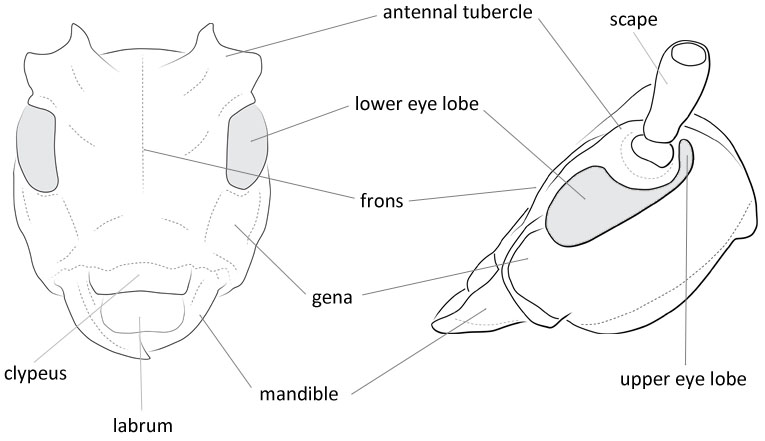 or subequal to lower eye lobeeye lobe:
or subequal to lower eye lobeeye lobe:
used to refer to the upper or lower portion when the eye is emarginate or separated .
.
Pronotum:pronotum:
the upper and dorsal part of the prothorax
dense setaeseta:
a sclerotized hair-like projection of the cuticle
on dorsum of lateral spines present; maculaemacula:
a spot or mark
on pronotal disk: 2–4 dots present or absent; posteromedial tubercletubercle:
a small knoblike or rounded protuberance
absent; lateral erect setaeseta:
a sclerotized hair-like projection of the cuticle
: only present posterior to spinespine:
a protuberance with an acute (sharp) distal end
.
Scutellum:scutellum:
a small sclerite located directly posterior to the pronotum, bordered laterally by the elytra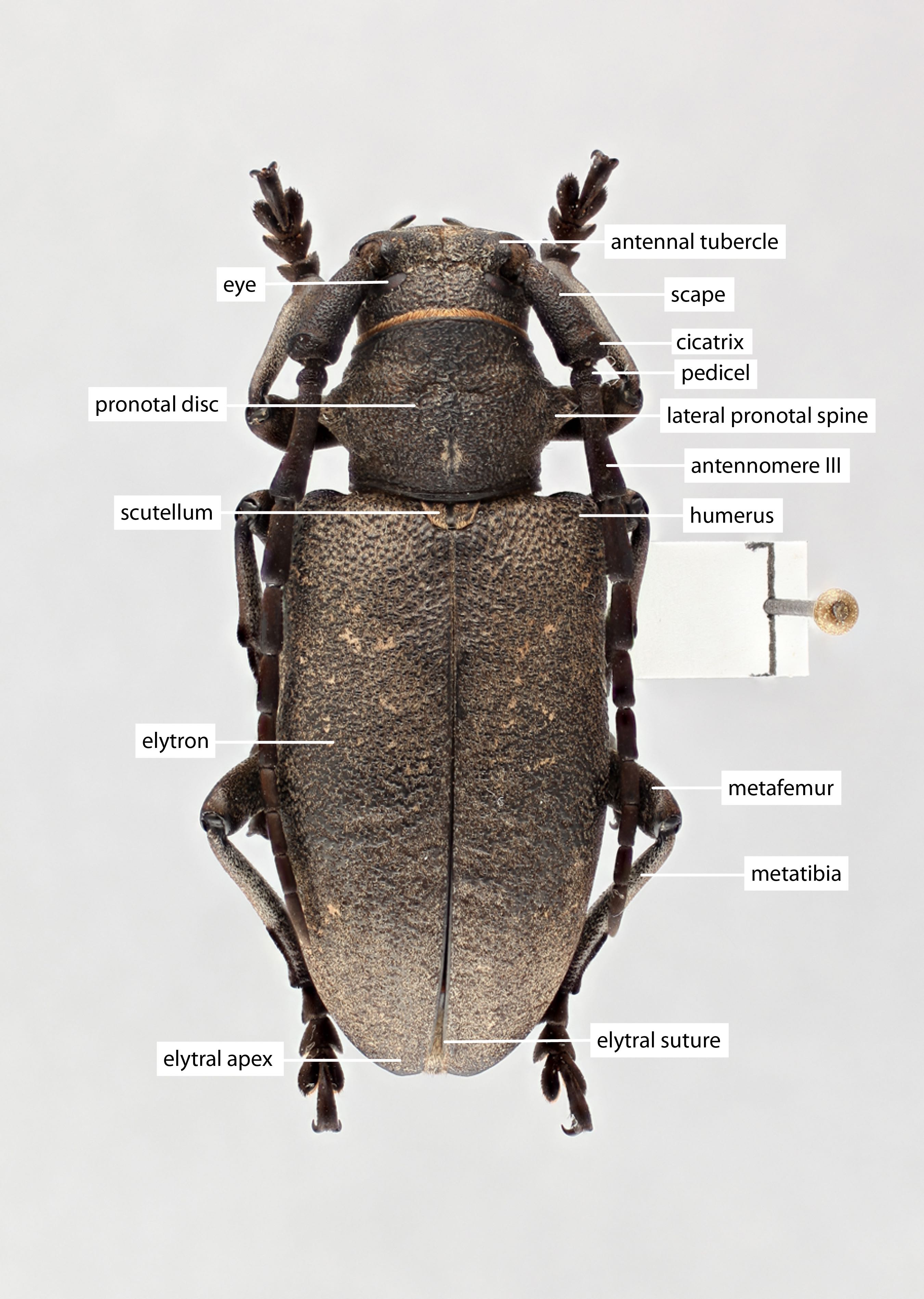 pubescence broken at least partially along midline.
pubescence broken at least partially along midline.
Elytra:elytron:
the leathery forewing of beetles, serving as a covering for the hind wings, commonly meeting opposite elytron in a straight line down the middle of the dorsum in repose
elytral integument color orange to red; elytral maculaemacula:
a spot or mark
: pubescence forming narrow longitudinal lines; elytral sutural apexapex:
end of any structure distad to the base
rounded; elevation in basal third followed by impression absent; basal granulation nearly absent; middle to apical punctationpunctation:
pits or depression of variable size in cuticle
fine.
Antennal length (female): >1–2 segments beyond or 2–3.5 segments beyond elytral apexapex:
end of any structure distad to the base
.
Aedeagus:aedeagus:
in male beetles, the penis
paramereparamere:
A pair of finger-like structures that are located where the male genitalia exits the abdomen.
mediobasal tooth present; apical tip (ventral view) slightly rounded; scleritesclerite:
any hardened plate of the body wall bounded by membrane or sutures; sometimes found floating in the internal sac of male genitalia
in internal sac: scleritesclerite:
any hardened plate of the body wall bounded by membrane or sutures; sometimes found floating in the internal sac of male genitalia
absent.
Male. Form large, tapering posteriorly, integument reddish-piceous, elytraelytron:
the leathery forewing of beetles, serving as a covering for the hind wings, commonly meeting opposite elytron in a straight line down the middle of the dorsum in repose
and outer antennal segments usually dark reddish-brown; pubescence recumbent, mostly grayish with small brown patches sparsely interspersed on elytraelytron:
the leathery forewing of beetles, serving as a covering for the hind wings, commonly meeting opposite elytron in a straight line down the middle of the dorsum in repose
. Head with front convex, shallowly, irregularly punctatepunctate:
set with fine, impressed points or punctures appearing as pin-pricks
, irregularly clothed with white recumbent pubescence; genaegena:
the part of the cranium on each side below the eye longer than lower eye lobeeye lobe:
longer than lower eye lobeeye lobe:
used to refer to the upper or lower portion when the eye is emarginate or separated , parallel; antennaeantenna:
, parallel; antennaeantenna:
in larval and adult insects, paired segmented appendages, borne one on each side of the head, functioning as sense organs and bearing a large number of sensilla
extending about six segments beyond elytraelytron:
the leathery forewing of beetles, serving as a covering for the hind wings, commonly meeting opposite elytron in a straight line down the middle of the dorsum in repose
, segments minutely asperate, segments three to nine with apical sensory areas, scapescape:
the first proximal segment of the antenna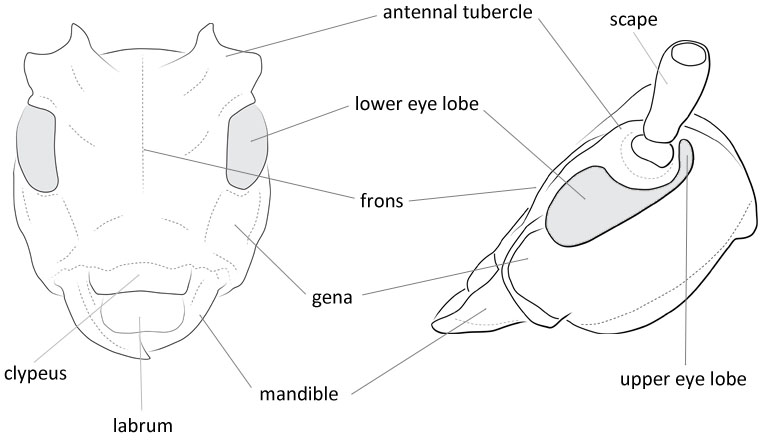 rather densely pubescentpubescent:
rather densely pubescentpubescent:
downy; clothed with soft, short, fine, loosely set hair
, remaining segments rather sparsely clothed with very short recumbent pubescence, eleventh segment arcuatearcuate:
arched or bow-like
. Pronotumpronotum:
the upper and dorsal part of the prothorax
as long as broad, lateral tubercles prominent, rounded at apicesapex:
end of any structure distad to the base
; apexapex:
end of any structure distad to the base
and basebase:
the part of any appendage or structure that is nearest the body
broadly impressed; disk with a median callus and a broad swelling on each side; punctures fine, irregular, sparse around median callus, remainder almost im punctatepunctate:
set with fine, impressed points or punctures appearing as pin-pricks
; pubescence whitish, irregular, recumbent, denser around lateral tubercles; prosternum ruguloserugulose:
minutely rugose; minutely wrinkled
, rather densely pubescentpubescent:
downy; clothed with soft, short, fine, loosely set hair
; meso- and metasternum irregularly punctatepunctate:
set with fine, impressed points or punctures appearing as pin-pricks
at sides, densely, nonuniformly pubescentpubescent:
downy; clothed with soft, short, fine, loosely set hair
, long, suberect hairs numerous. Elytraelytron:
the leathery forewing of beetles, serving as a covering for the hind wings, commonly meeting opposite elytron in a straight line down the middle of the dorsum in repose
less than 2.5 times as long as broad; basebase:
the part of any appendage or structure that is nearest the body
with scattered, small, rounded asperites, denser on humerihumerus:
shoulder; the basal exterior angle of the elytra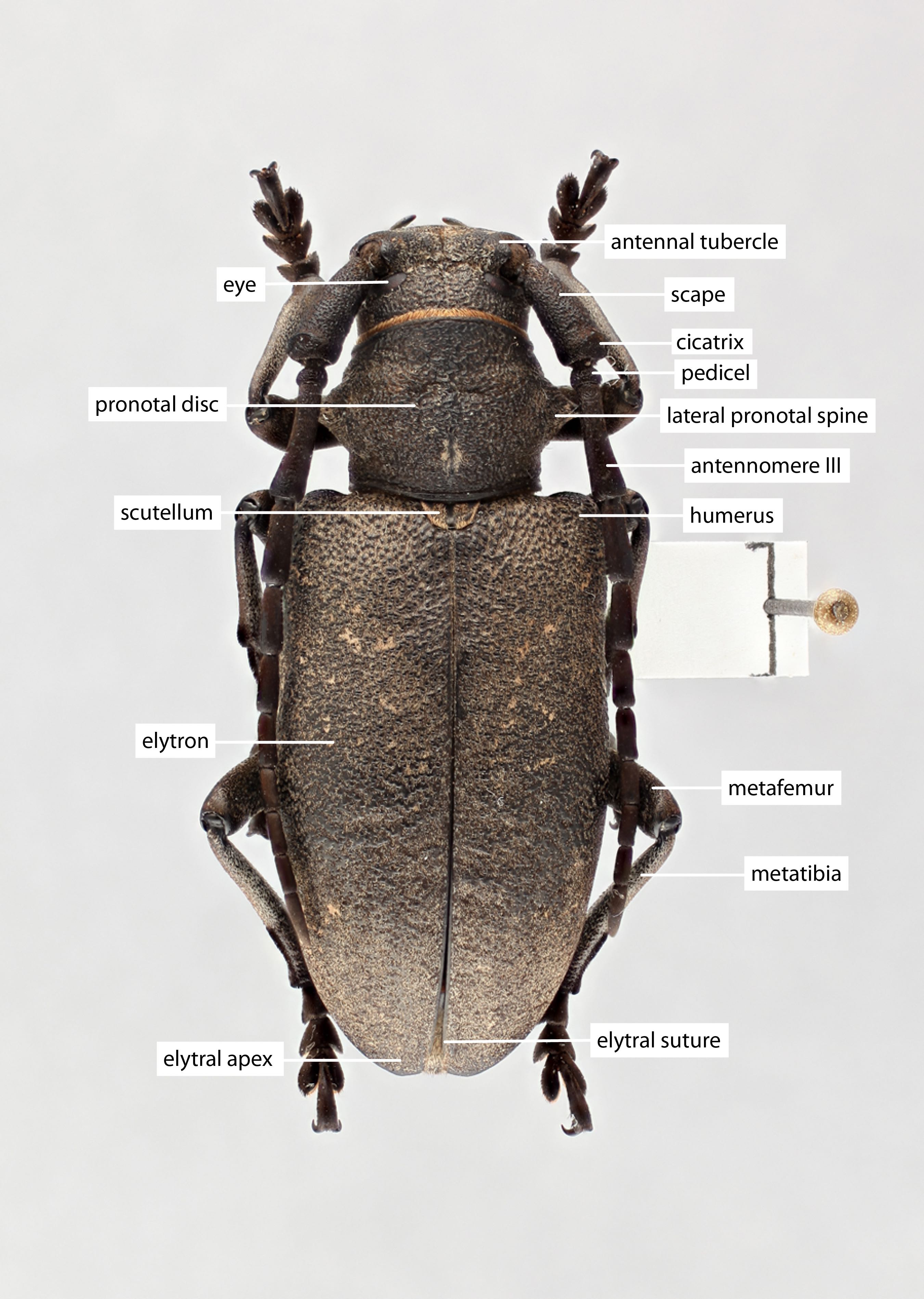 ; punctures behind small, rather sparse, becoming obsolete toward apexapex:
; punctures behind small, rather sparse, becoming obsolete toward apexapex:
end of any structure distad to the base
; pubescence recumbent, mostly gray, mottled, with a few small patches of brown interspersed; apicesapex:
end of any structure distad to the base
rounded, vaguely angulate at sutures. Scutellumscutellum:
a small sclerite located directly posterior to the pronotum, bordered laterally by the elytra broader than long, white pubescentpubescent:
broader than long, white pubescentpubescent:
downy; clothed with soft, short, fine, loosely set hair
except for median line, rounded at apexapex:
end of any structure distad to the base
. Legs irregularly white pubescentpubescent:
downy; clothed with soft, short, fine, loosely set hair
; femora with a few, short golden hairs interspersed. Abdomen densely, irregularly pubescentpubescent:
downy; clothed with soft, short, fine, loosely set hair
, finely punctatepunctate:
set with fine, impressed points or punctures appearing as pin-pricks
; last sternite subtruncatesubtruncate:
not quite cut off squarely at the tip
at apexapex:
end of any structure distad to the base
, often shallowly emarginateemarginate:
notched at the margin at middle, sides with a few long, erect hairs. Length, 23–35 mm.
at middle, sides with a few long, erect hairs. Length, 23–35 mm.
Female. Form more robust, parallel. Head with front flat, broad, genaegena:
the part of the cranium on each side below the eye divergentdivergent:
divergentdivergent:
spreading out from a common base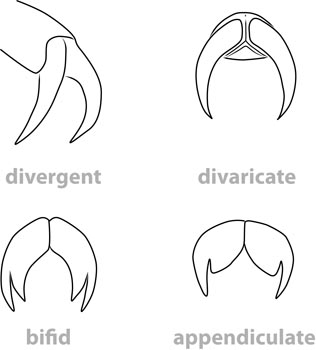 ; antennal tubercles much less prominent, more divergentdivergent:
; antennal tubercles much less prominent, more divergentdivergent:
spreading out from a common base ; antennaeantenna:
; antennaeantenna:
in larval and adult insects, paired segmented appendages, borne one on each side of the head, functioning as sense organs and bearing a large number of sensilla
extending about two segments beyond elytraelytron:
the leathery forewing of beetles, serving as a covering for the hind wings, commonly meeting opposite elytron in a straight line down the middle of the dorsum in repose
. Abdomen with last sternite emarginateemarginate:
notched at the margin at apexapex:
at apexapex:
end of any structure distad to the base
, each side with large tufts of black hairs. Length, 24–35 mm. (Linsley and Chemsak 1984Linsley and Chemsak 1984:
Linsley EG and Chemsak JA. 1984. The Cerambycidae of North America. Part VII, No. 1. Taxonomy and Classification of the Subfamily Lamiinae, Tribes Parmenini Through Acanthoderini. University of California Press, Berkeley and Los Angeles. 258 pp.)
The grayish color, mostly white pronotumpronotum:
the upper and dorsal part of the prothorax
, usual large size, large female face, and unarmed sutural apexapex:
end of any structure distad to the base
will distinguish this species.
eastern to northwestern USA, southern Canada
Pinus spp., Picea, Abies
Lamia varia Frölich, 1792: 144
Monochamus confusor Kirby, 1837: 168
Monochammus peregrinus Gradl, 1881: 301
Monochamus notatus morgani Hopping, 1945: 17